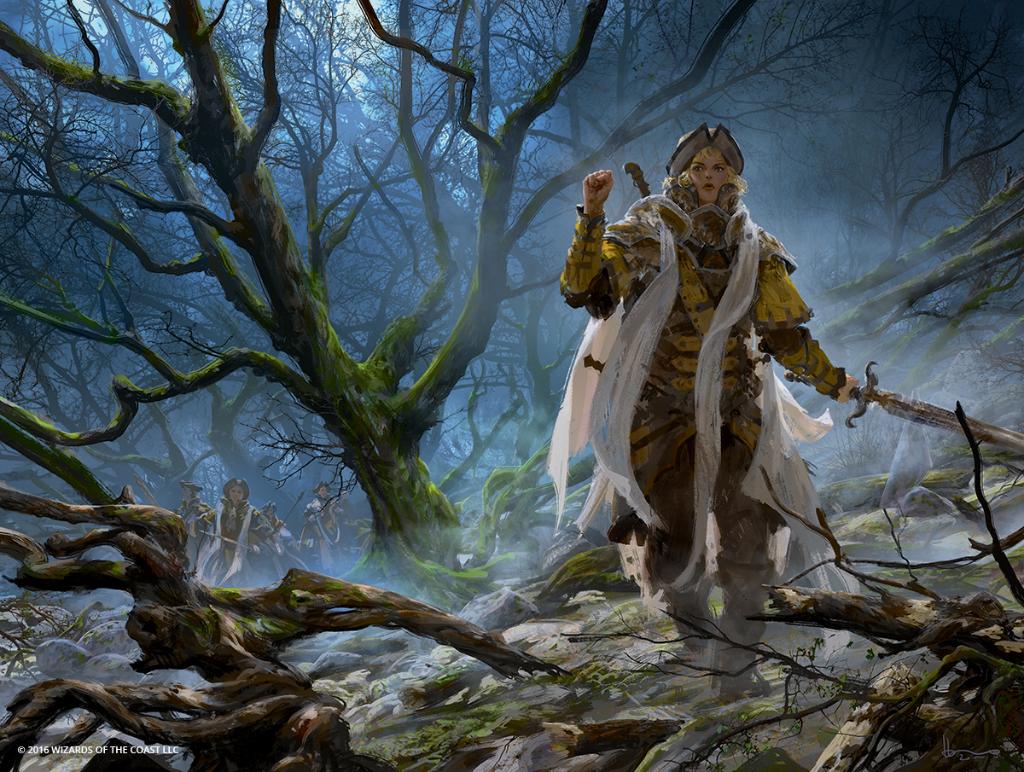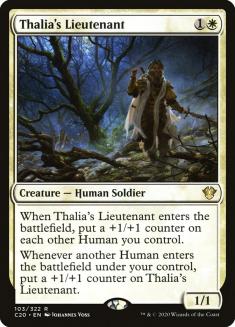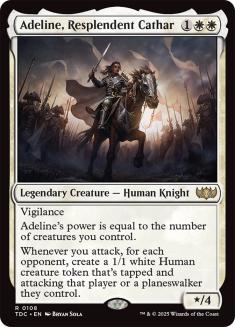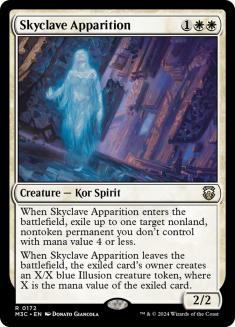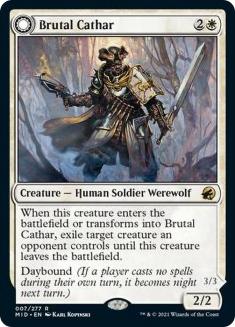It’s taken a while, but the hive mind has finally figured out that the disaster of a metagame Pioneer suffered through in 2020, with Dimir Inverter and other combo decks running rampant, is a thing of the past. And they’re now returning to the format that had so much promise when it was announced in 2019. Now we get to find out if the diverse metagame Pioneer currently enjoys is truly indicative of great balance in the card pool or is simply a result of the format being currently underexplored.
Personally, I think Pioneer will shake out to be a format with the diversity of Modern, but without the burden of playing with fetchlands, so I’m excited to dive back into the format. The last deck I was playing in 2020 was Orzhov Humans, and as it turns out, that’s one of the more popular aggressive decks in the current metagame, so that’s where I’m starting.
I’ve long thought Thalia’s Lieutenant was among the most powerful cards in Pioneer that wasn’t seeing significant play, but the Human tribe has had two issues that kept it from ascending to Tier 1. The first is that our collective idea of Humans comes from Modern, where it’s a disruptive aggro deck with a unique manabase, allowing it to utilize only the most powerful individual Humans in the format.
That’s a much tougher sell in Pioneer, where you don’t have access to Cavern of Souls or Ancient Ziggurat. Nor do you have Aether Vial to help out for your splash colors in the odd game where you didn’t have a rainbow land. Because of that, you have to focus on one or two colors, where white is your main color. This means you’re drawing from a much smaller card pool of creatures to build your deck, putting a ceiling on the deck’s power level.
This brings us to the second issue, which was a low density of quality creatures to fill out the deck’s curve. Recent printings of Elite Spellbinder and Thalia, Guardian of Thraben have gone a long way towards remedying that problem, so much so that there are now two different builds of Humans seeing significant play. There’s the aforementioned Orzhov variant and a Selesnya build.
Creatures (33)
- 2 Knight of the White Orchid
- 3 Thalia, Guardian of Thraben
- 3 Kytheon, Hero of Akros
- 4 Thraben Inspector
- 4 Thalia's Lieutenant
- 4 Dauntless Bodyguard
- 2 Giant Killer
- 4 Skyclave Apparition
- 3 Brutal Cathar
- 2 Augur of Autumn
- 2 Adeline, Resplendent Cathar
Lands (23)
Spells (4)

Creatures (30)
- 4 Thalia, Guardian of Thraben
- 4 Bloodsoaked Champion
- 1 Kytheon, Hero of Akros
- 4 Thraben Inspector
- 4 Thalia's Lieutenant
- 4 Kitesail Freebooter
- 4 Dauntless Bodyguard
- 1 Giant Killer
- 4 Luminarch Aspirant
Lands (22)
Spells (8)

Let’s take a look at how these decks compare in key areas for aggressive decks.
Curve
Orzhov plays a lower curve in order to facilitate Lurrus of the Dream-Den as a companion, while Selesnya plays a higher curve in order to maximize Collected Company. So while it’s theoretically possible for Selesnya to lower its curve to match Orzhov’s, there’s little incentive to do so since Collected Company is the reason to splash green.
In general I’d rather play the aggressive deck with the lower curve, with one exception. And that’s when the higher curve deck has a significantly better individual card power level. In this case, there’s a ton of overlap and Orzhov has the advantage at the one- and two-mana slot with the additions of Bloodsoaked Champion and Kitesail Freebooter. So for Selesnya to have the advantage here, its three-mana creatures have to pull a lot of weight.
I’m a huge fan of Adeline, Resplendent Cathar and would certainly play more than the two copies I commonly see in Selesnya lists, but past that the three-mana creatures are your interactive cards. Those are good cards no doubt, but not enough to make me want to play a much higher curve in a format with many powerful combo and control decks that go over the top of you.
Advantage: Orzhov
Resilience
While aggro decks are generally trying to end the game quickly, you have to be able to win games that don’t go according to plan. Orzhov uses Lurrus as a companion as a means to grind through heavy removal strategies, while Selesnya has the card advantage from Collected Company. Both decks also have Mutavault, but Orzhov plays more copies since it has more dual lands.
Some Orzhov lists have Thoughtseize in the maindeck, which can help set up Lurrus to stick on the battlefield for multiple turns, but ultimately I don’t think doing so helps the deck overall since it cuts into your threat density. Without consistent discard, your Lurrus is likely to only draw one card, but it comes along for free and you have access to it every game. At this point I think we all understand how powerful Lurrus is.
Collected Company is more powerful when it hits, especially since you can leave it up to cast on your opponent’s end step after a sweeper, but you have to draw it and the mana to cast it at the appropriate time. Combine that with the natural variance of the card, and I’m siding with Lurrus on this one.
Advantage: Orzhov
Interaction
One of the tougher things to get right when building aggro decks is how many and exactly which interactive cards you should play. Aggro decks need to consistently get ahead, and playing too many reactive cards will impede that goal. But if you don’t have enough interaction, you’ll be felled by large creatures holding back your team too often.
Selesnya Humans skirts this issue in an elegant way by using creatures as its removal spells. Brutal Cathar and Skyclave Apparition keep your threat density high while also answering a wide range of creatures and other permanents. That versatility is important when you don’t have room to play specialized answers like midrange and control decks can. Moreover, having your removal tacked onto creatures means Collected Company gives you increased access to interaction.
Orzhov Humans can’t play Cathar or Apparition because of Lurrus’s restriction, so they’re forced to turn to black spells like Dire Tactics, Fatal Push, and Bloodchief’s Thirst for removal. These spells all have their merits, and you can customize which ones you play in the maindeck versus the sideboard based on the metagame, but they all take away from your threat density.
However, black also gives you access to hand disruption in Kitesail Freebooter and Thoughtseize. Selesnya has some Elite Spellbinders in the sideboard, but there’s no room in the maindeck, so they don’t move the needle. This means Orzhov Humans has a more versatile suite of interaction than Selesnya can run. I’m a fan of versatility, but in this case threat density is too important. Unless you’re expecting a metagame full of control and combo decks, Selesnya has the edge here.
Advantage: Selesnya
Manabase
Pretty similar here. Lots of Plains. All the best dual lands available for your splash color. And as many Mutavaults as you can fit without hurting the color requirements. But as has been the case since the format’s inception, the enemy-color pair has an advantage.
Orzhov has a painland and a fastland that Selesnya doesn’t, so it can eschew the weak checkland that Selesnya is forced to play, while also fitting in more copies of Mutavault, even with a generally lower land count. A couple Mutavaults may not seem like a big deal, but it’s one of the most powerful lands in Pioneer and a huge boon in both closing out games and winning through removal.
I long for the day when the fastland cycle is completed for Pioneer and there’s more balance in aggro deck manabases, but until then it’s a clear advantage to Orzhov on this one.
Advantage: Orzhov
Sideboard
When you look at the sideboards in the lists above, you see a lot more black cards in Orzhov’s than green cards in Selesnya’s. But it’s mostly removal that Orzhov is playing, to an excessive degree in my opinion, so I’m not willing to chalk it up to Orzhov immediately. It’s also important to note that three-mana creatures like Elite Spellbinder in the Selesnya sideboard are nominally playable for Orzhov but a hard sell in practice with Lurrus to think about.
But when I look closer, I just don’t see much that green is adding here. Heron’s Grace Champion and Yasharn, Implacable Earth are solid creatures, but you can’t play too many copies or you’re hurting your Companys, and sacrifice decks for Yasharn to hit aren’t that popular right now. Shapers’ Sanctuary can be quite powerful, but it’s super-inconsistent since you need to cast it early.
You could also look to various disenchant creatures like Outland Liberator, but Skyclave Apparition covers you there. Tireless Tracker is a solid option to combat attrition decks, but overall green doesn’t contribute much.
Black of course offers good cheap removal, though Portable Hole means you’re not gaining much over Selesnya. The real coup here is Thoughtseize. It’s one of the best cards in Pioneer, and some builds of Orzhov Humans even maindeck it. It’s great against almost any control or combo deck, and is miles ahead of any other sideboard card in either build.
Advantage: Orzhov
So overall, I’d default to the Orzhov Humans build. But that doesn’t mean Selesnya doesn’t have a place. These decks are different enough that certain metagames will favor the green splash. In particular, metagames where there aren’t a lot of combo or control decks, so playing to the battlefield with powerful creatures is a winning strategy, will favor Selesnya relative to Orzhov.
Now let’s look at how I would build each of these decks, starting with Selesnya.
My Selesnya Build
Creatures (33)
- 3 Thalia, Guardian of Thraben
- 2 Kytheon, Hero of Akros
- 4 Thraben Inspector
- 4 Thalia's Lieutenant
- 4 Dauntless Bodyguard
- 3 Giant Killer
- 4 Skyclave Apparition
- 3 Luminarch Aspirant
- 3 Brutal Cathar
- 3 Adeline, Resplendent Cathar
Lands (23)
Spells (4)

When I’m playing an aggro deck, consistency is one of the main attributes I’m looking for. So I’m not a fan of Knight of the White Orchid, which too often is a glorified Grizzly Bears. Instead I’d rather take a more aggressive stance with Luminarch Aspirant, a card that has impressed me quite a bit in Pioneer. It offers great control over combat whether you’re ahead or behind; just remember to Collected Company on your main phase if the counter matters.
I also added another Adeline, a card I’ve always been impressed with, cutting Augur of Autumn entirely since it’s so difficult to cast. Adeline singlehandedly forces a sweeper or at least an immediate answer or it will take over the game. That’s the exact kind of card I like pairing with Collected Company.
In the manabase, I’m maxing out on Sunpetal Groves and eschewing the basic Forest, since the latter often prevents you from curving out properly, even if it enters untapped where Sunpetal Grove wouldn’t. It’s annoying when you draw too many of them and have to play awkwardly around tapped lands, but it’s the price of playing a allied-color pair in Pioneer.
In the sideboard, I went with Tireless Tracker over Shapers’ Sanctuary since the former is a more consistently good card, and to keep the creature count up. I also went up on Elite Spellbinder and Portable Hole since, once again, they are consistently good cards. Vanquish the Horde can be game-breaking, but that’s why I like the singleton copy. It won’t clog your hand too often, and you’ll still get the chance to realize its potential.
My Orzhov Build
Creatures (32)
- 3 Thalia, Guardian of Thraben
- 4 Boros Elite
- 4 Bloodsoaked Champion
- 1 Kytheon, Hero of Akros
- 4 Thraben Inspector
- 4 Thalia's Lieutenant
- 4 Kitesail Freebooter
- 4 Dauntless Bodyguard
- 1 Giant Killer
- 3 Luminarch Aspirant
Lands (22)
Spells (6)

With Orzhov Humans, my main goal was to lower the deck’s curve considerably. The balance of two-drops against one-drops in the stock list was off, leading to too many clunky draws where you couldn’t double-spell on Turn 3. The fact that you have Lurrus every game makes it much easier to err towards cheaper cards and use the early pressure to whittle away your opponent’s resources, letting Lurrus enter on an empty battlefield.
However, no single card offered an easy cut, so I had to trim around the edges. Rally the Ranks was the easiest trim, since it depends on threat density and the deck has too many noncreatures. I also cut a copy of Dire Tactics, which is the removal spell I favor in the maindeck for versatility’s sake. You don’t need much removal in the maindeck of a deck like this, as you can overwhelm blockers by going wide with your many Anthem effects.
Next I had to trim on two-mana creatures, and I decided on Luminarch Aspirant and Thalia, Guardian of Thraben. Thalia can be awkward in multiples or with your noncreature spells, and Luminarch Aspirant, while a good card, was a necessary axe to get the curve where I wanted it. Kitesail Freebooter hasn’t impressed me much in Modern, but it offers unique disruption and, perhaps as importantly, a body with evasion that can eke out games when the ground stalls.
My only additions to the sideboard are Deafening Silence and Rest in Peace. I think both enchantments are excellent in the current metagame. They can both interfere with your plan, whether it’s casting multiple spells or utilizing Lurrus, but they’re still worthwhile. Deafening Silence only affects noncreature spells, and it’s rare that you cast more than one of those in a turn. And in matchups where Rest in Peace is good, it’s worth a lot more than the card advantage from Lurrus. Just don’t bring it in when it’s mediocre.
It almost feels like we’ve hit the reset button on Pioneer, given how few eyes have been on the format over the last year. That makes it important to look for decks with powerful build-around cards. Thalia’s Lieutenant is one of the best there is when it comes to aggro strategies, and both of these decks have a lot more going for them than just blindly attacking. It’s time for aggro in Pioneer to mean more than Mono-Red and Mono-Black.

